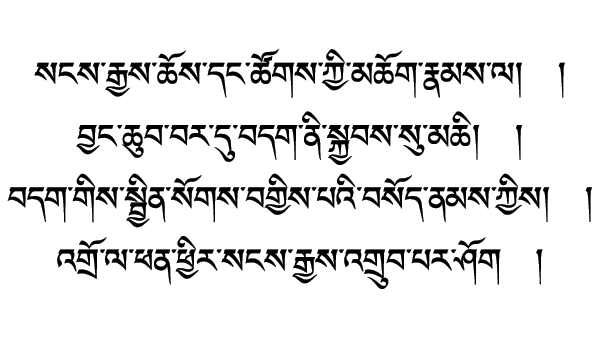Venerable Lama Tenpa Gyamtso
Experiencing Faith and Devotion in Our Lama
&
Abiding in the Calm of Our Mind
and Looking at its True Nature

Most Venerable Kalu Rinpoche always taught that three stages of meditation need to be practiced in this sequence: calm abiding, special insight meditation, and Yidam practice. Having explained the practice of meditating the elements, I wish to speak about cultivating and experiencing faith and devotion in our Lama and abiding in the true nature of our mind after we do a short meditation together.
The ability to abide in one's mind is attained by exerting oneself in regular and diligent meditation practice. A student who is able to rest in the peace of his or her own mind will notice the great benefit of keeping the mind in its own place, will experience joy, and will reserve time to practice every day. There is so much upheaval in the world, so people's minds are very agitated and disturbed. Keeping one's mind in the state of calm and ease through calm abiding meditation practice is very good. Whether focusing on an object or practicing without focusing on an object, the most important point in calm abiding meditation is not giving in to distractions.
It isn't easy for beginners to keep their mind focused during calm abiding meditation, so it's helpful to practice in a group; meditating with a Lama is also a very strong support. It's very beneficial for lay-practitioners to take time off from their daily obligations and chores in order to practice calm abiding meditation. When disciples feel exhausted and want to rest and relax, practicing calm abiding meditation refreshes immensely.
Calm abiding meditation is the foundation for all other meditation practices. It is the practice by which disciples learn to gain control of their mind and to become independent, which is very important if one aspires to mature and progress spiritually. It's not easy pursuing any higher education at college or university either - every student needs to work hard in order to succeed. It's the same with calm abiding. One needs to practice diligently, and being able to abide in calm and ease is very good for every meditation practice. Any work or studies one does will also go smoothly as a result.
Let us practice calm abiding meditation together for a short while now. I want to ask you to watch your breathing and count your ingoing and outgoing breath 21 times. /Short meditation./
One needs prerequisites if one aspires to realize the nature of one's mind and experience Mahamudra, and the prerequisites are having faith and devotion and accumulating merit and wisdom. That is what one needs - no more.
There are many methods to accumulate merit and wisdom, basically taking refuge, generating the mind of awakening, contemplating the four preliminary practices of Ngöndro, meditating Dorje Sempa, and making Mandala offerings. Practicing Guru-yoga then enables a disciple to develop and cultivate faith and devotion in his or her Lama. Meditating a Yidam, repeating the respective Mantra, and engaging in the six perfections are also means to accumulate merit and wisdom.
It's very important not to be narrow-minded when hoping to accumulate merit and wisdom. Striving for the sake of one's own well-being is an erroneous motivation and is not what is meant. The true motivation is including everyone. It's the sincere wish to benefit all living beings through one's practice, and this is what is meant by accumulating merit and wisdom.
How does one accumulate merit and wisdom? One accumulates merit by engaging in the six perfections, which are generosity, ethics, patience, joyful endeavour, meditative concentration, and discriminating awareness. One accumulates wisdom by realizing and practicing free from what is referred to as "the three circles," which are belief in the independent existence of and attachment to a self, an object, and an action. One should practice accumulating merit and wisdom together. Meditating the creation and completion phases of a Yidam are the means to practice them together. One accumulates merit and wisdom together by being aware of the fact that the Yidam one produces during the creation phase of meditation practice is empty of inherent existence and by abiding in emptiness after having dissolved the visualization during the completion phase. One must be very attentive not to fall into the one phase of practice by underestimating the other and one should always remember the heart of awakening, which - as stated in "The Bodhicitta Prayer" - is having all living beings in mind while practicing to attain Buddhahood.
Any positive action one carries out - whether one is reciting "The Refuge and Bodhicitta Prayer," whether one is engaged in small or large wholesome actions - one should not differentiate between the one doing something, i.e., one should not divide into a subject, object, and action. It's very important to become accustomed to having good and beneficial habits and not to be divisive.
One needs to be aware of what one recites, i.e., one needs to know why one is taking refuge and what the mind of awakening means, and one always needs to have all living beings in mind while treading the spiritual path. Furthermore, one always concludes each practice session by dedicating the merit one was able to accumulate for the welfare of all living beings. These are the prerequisites if one wishes to attain enlightenment. So, good practice consists of taking refuge and giving rise to the mind of awakening, practicing the main body of the respective liturgy, and dedicating the merit. Then our practice will be complete and beneficial. But, it's necessary to practice diligently until meditation becomes a natural habit.
Why is it important to have faith and devotion in our Lama? Then our meditation will go well. How do we develop best faith and devotion in our Lama? By contemplating his qualities, by thinking about his extreme generosity, and by praying to him again and again. On a worldly level, everyone enjoys beautiful things and likes being entertained. If we want to develop and increase our faith and devotion in our Lama, it's good to be aware of what we enjoy in life. Everything our Lama does is the self-perfected manifestation of a yogi, so we should wish to transforms our mind so that we can fully appreciate our Lama's wonderful presence. If we have authentic faith and devotion in our Lama, tears come to our eyes and the goose-bumps we get cause every hair of our body to stand up. All our thoughts that are directed towards ourselves will cease when we have true devotion in our Lama, because our mind is never separated from him and so we are always happy. We abide in that experience of peace, and then Mahamudra is not out of reach.
A practitioner doesn't need to exert effort to realize Mahamudra if he or she has great faith and devotion in the Lama, because faith and devotion naturally move one to practice. It is said that someone who has become a Bodhisattva accumulated merit over a period of at least three aeons. True faith and devotion in one's Lama open doors. It's said that one unites with one's Lama through his blessings, that one's meditation will then be natural, and that one doesn't need to exert oneself for three aeons in order to progress spiritually.
There are Lamas who have attained the three eyes of wisdom and are therefore omniscient. When he spoke about this topic, Venerable Kalu Rinpoche told a story from the Kagyü Transmission Lineage known as Taklung, which is one of the eight smaller Kagyü Schools that originated from Phagdru Dorje Gyalpo, a heart-son of Lhaje Gampopa. Taklung Tulku, who founded the Taklung Kagyü Lineage but wasn't omniscient, had a very dedicated disciple who was convinced of his Lama's omniscience and therefore had immense faith and devotion in him. One day the disciple got sick, closed his eyes, and prayed intensively to his Lama. In his mind, he saw Taklung Tulku bless him while appearing before him, and in that moment he became cured of his sickness. It does happen that a Lama isn't that realized, but that his qualities manifest through the devotion on the side of a disciple.
There was once a Lama who presented many teachings, although he himself didn't really have any high realizations and experiences. This Lama had a very devoted disciple who looked up to him as a Buddha. The disciple had very strong devotion and a pure vision of his Lama and as a result he achieved realization. Due to his realization, the disciple could enter the pure realms of Devachen and of the Five Dhyani Buddhas. One day he searched for his deceased Lama, found him in the hell realm, and got him out. And so, if one relies upon a Lama, it's very good to recognize that he is the embodiment of refuge by seeing his body as the Sangha, his speech as the Dharma, and his mind as a Buddha.
Having trained to be mindful and aware, it's good to look at one's mind and to try to find whether it has a color or not - whether it is yellow, white, red, or blue, etc. Then it's good to investigate whether one's momentary mind has a form or not - whether it's round, square, or triangular, etc. Then one should try to find out whether one's mind is a phenomenon or not - like a bird, an insect, or other phenomenon that consists of substances one can name and list. One discovers that no "thing" is there that one can call one's mind. But, it's not the case that it is nothing. For instance, one is happy when someone says something nice and unhappy when someone says something not so nice. One needs to look at one's feelings and examine them. Looking at feelings, one discovers mind's clarity and then looks at this clarity precisely. By practicing in this way, one sees that the nature of mind's clarity is emptiness, i.e., devoid of independent, solid, lasting existence. So, mind is empty of true existence and is clear at the same time - it is the indivisibility of emptiness and clarity. Seeing that the mind is clear is possible due to its empty essence, which means to say that emptiness and clarity are inseparably united and never apart. They are not even as divided as black and white threads twisted around each other to make a thread of yarn - emptiness and clarity are not like the two threads one can call "black" and "white" of that thread of yarn. Every living being has a mind that is the indivisibility of emptiness and clarity, even the tiniest insect. There is no thing like a "big mind" and "a little mind," because the mind of a human being and that of a tiny living being have the same characteristics in that they are both empty and clear.
All living beings have the same potential to experience and manifest the three Kayas, the "bodies of a Buddha." Mind's emptiness is the Dharmakaya, and mind's clarity is the Sambhogakaya. Mind's unimpeded appearance is the Nirmanakaya. Being inseparable, they are the Svabhavikakaya. The mind of every living being is endowed with the three Kayas.
Someone whose mind is overwhelmed by mental and emotional delusions is said to be entangled in samsara. Someone who has purified his or her mind of delusions is said to abide in Nirvana. They are like turning one's hand around, nevertheless it's the same hand. In the same way, all living beings are endowed with the Buddha nature, which is basic goodness. In the treatise, entitled "Uttaratantrashastra," Buddha Maitreya explained why all delusions that obscure one's true nature, which is Buddha nature, are adventitious and transitory; delusions are impermanent and conceal the qualities of Buddhahood that every living being has. His Holiness the Dalai Lama spoke about this in Zürich recently when he presented teachings on Shantideva's treatise, entitled "Bodhicharyavatara." He taught that the delusions obscuring one's Buddha nature are fleeting stains, which means to say that they can be cleansed.
Let me stress that the stains obscuring the ground of one's being are impermanent. Therefore one needn't think that Mahamudra is far away. One can realize Mahamudra by purifying the veils that conceal one's true nature. But, one needs to know and recognize how one's mind functions and truly is. As mentioned, mind's true nature is the indivisibility of emptiness and clarity. In order to realize this, one needs to learn to allow one's mind to be at peace and at ease, which is presently not the case. As long as one follows after thoughts that arise, one's mind is perturbed and one is in a continuous, moving stream of discursiveness.
Recognizing that one's mind is perturbed or at ease is due to one's basic awareness, rig-pa in Tibetan. Whether one's mind is agitated, or at ease, or aware, all are aspects of the same mind, which practitioners come to realize through meditation.
It's necessary to always look to see what is taking place in one's mind - whether it abides in calm, whether it moves by following after thoughts, and how it functions. Awareness needs to be cultivated by looking to see whether one's mind is a single entity, consists of different parts, and so forth - it means knowing what is taking place in one's mind by looking at it again and again and then allowing it to abide in its true nature. This is an ongoing practice and leads to a personal experience. Experiencing one's own mind is not an intellectual matter, rather it's a matter of looking directly at one's own mind. Real meditation consists of examining and looking at one's own mind and leads to experiences. Students can discuss emptiness as long as they want, but they won't experience their own mind as long as they don't turn their attention inwards, investigate, and look at their own mind. So, meditation means examining one's own mind and resting in it.
Let me speak about what abiding in mind's authentic presence means. The Lojong-Teachings of Jowo Atisha state: Do not ponder the past, which leads astray. Do not make plans for the future, rather abide in the present mind without succumbing to discursiveness. Resting in mind's true presence means being free from mental fabrications, which is also called "simplicity" and is not artificial. If thoughts arise while meditating (for instance, that one is abiding in the true nature of one's mind, or if one thinks one wants to meditate on one's mind, or that practicing is boring), then one's mind has moved. Any thought one follows is a mental fabrication that distracts from resting in the true nature of one's mind. Furthermore, one shouldn't think that it's necessary to dissever or block thoughts, but one should appreciate and acknowledge that thoughts are the self-perfected manifestation of one's wisdom-awareness. During meditation, a practitioner simply notices that a thought has arisen, doesn't follow after it, and doesn't wish to get rid of it either.
Every thought is an expression or manifestation of one's mind, and the essence of every thought is the Dharmakaya. That's why the Dharmakaya, the "truth body," is so near - it is one's present mind and can be compared to the ocean. Waves, which can be compared to thoughts, are not produced but are the natural display of the ocean that they appear on. Thoughts naturally flow back into the mind again, just like waves naturally subside into the ocean, i.e., thoughts are not different than the mind, just like waves are not separate from the ocean.
And so, we should develop deep and sincere devotion in our Lama. We should also accumulate merit and wisdom. Thank you very much.
Dedication Prayers
Through this goodness may omniscience be attained
And thereby may every enemy (mental defilement) be overcome.
May beings be liberated from the ocean of samsara
That is troubled by waves of birth, old age, sickness, and death.
May the life of the Glorious Lama remain steadfast and firm.
May peace and happiness fully arise for beings as limitless in number as space is vast in its
extent.
Having accumulated merit and purified negativities, may I and all living beings without exception
Swiftly establish the levels and grounds of Buddhahood.

Presented at Karma Chang Chub Choephel Ling in Heidelberg in September 2008. Sincere gratitude to Lama Dorothea Nett and to Hans Billing for all that they are doing and to Bärbel Reinschmidt for having translated from Tibetan into German; translated into English and edited by Gaby Hollmann, solely responsible for all mistakes. May goodliness increase!















